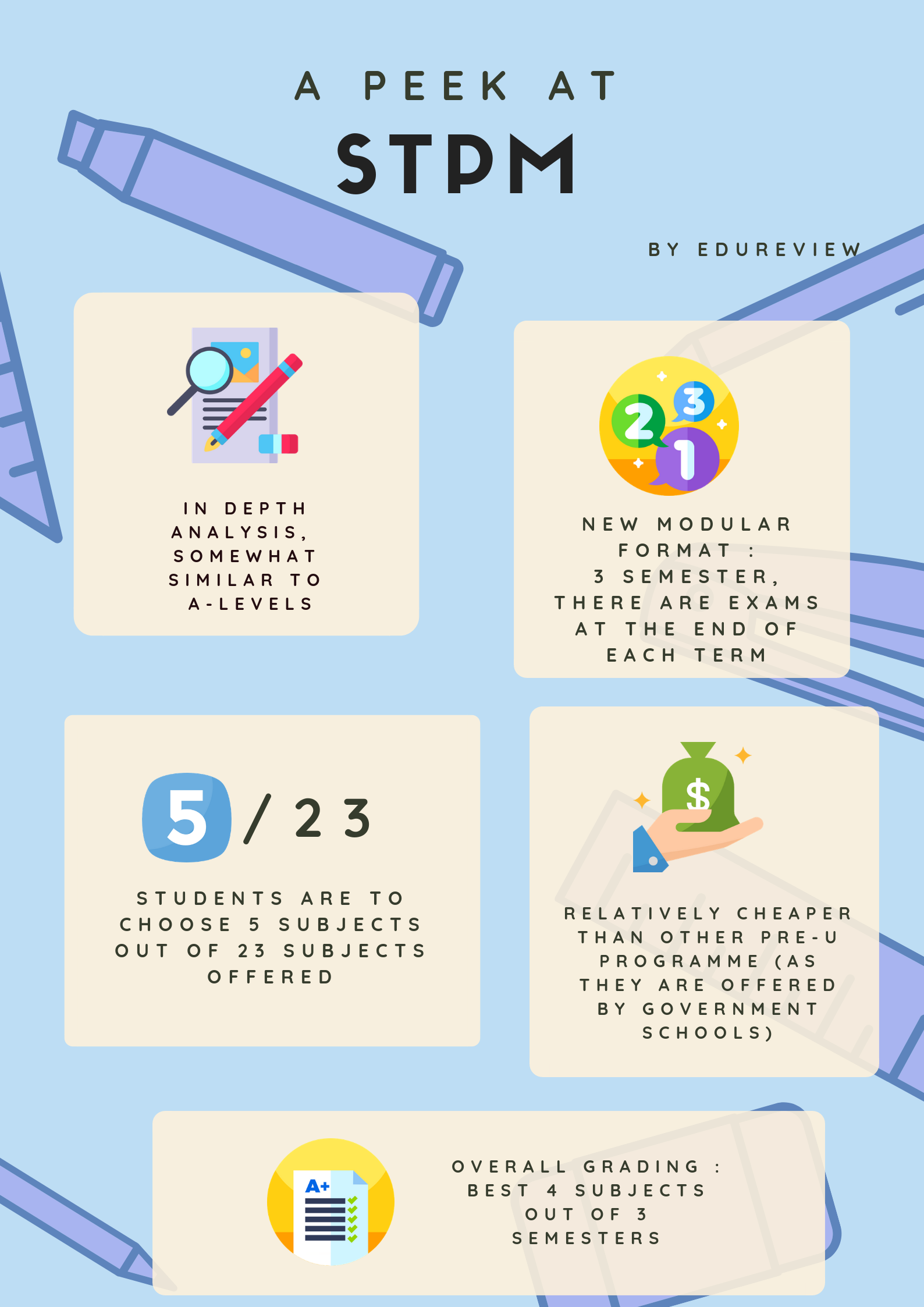If you choose to further your studies locally, then there is no need to spend so much money on international pre-university programmes. There are many choices of local programmes offered in our very own country. Given the lower tuition fees, don’t be surprised with the quality of these local programmes! A sequel to our article “Pre-University 101: Everything You Need to Know” an overview in deciding a pre-university programme, we will explore local pre-university courses in more depth in this article.
If you want to know more about international programmes, do click here.
Comparison between Pre-University Programmes
As discussed in the previous article, the few criteria that you can use in comparing the programmes are course duration, timing of intake, subject choices, assesment method, tuition fees and more. We will summarise the differences between various pre-university programmes in the table below for your easy understanding and comparison.
1) Matriculation (Matrikulasi)

Overview
The Malaysian Matriculation Programme (also known as Matrikulasi) is offered by Malaysia’s Ministry of Education (MOE). The course is rather different than the rest of the pre-U courses as 90% of the spots in Matriculation are reserved for Malay students – typically of low to middle-class backgrounds. Due to its affiliation with the government, in terms of cost, students only have to pay a small registration fee. Upon application, the students will also receive an allowance each semester, making it one of the more popular choices for Bumiputera students.
Although the course is recognised by some Commonwealth nations, it is primarily aimed for students who want to pursue their tertiary education locally. The syllabus is pretty similar to STPM and you will be taking approximately 8 subjects in total. Nevertheless, Matriculation can be shorter and the subjects are not as complex as STPM.
The Matrikulasi programme offers three streams, which are:
- Science stream (one-year or two-year)
- Accounting stream (one-year only)
- Technical stream (one-year only)
Assessment method/grading system
Below is how you will be assessed during the course :
| Subjects | Assignments / Coursework | Mid-semester exam | Final semester exam |
| Core subjects | 10%-20% | 10% | 70% – 80% |
| Compulsory subjects | 100% | Not applicable | Not applicable |
| English | 40% | 10% | 50% |
Similar to foundation and diploma, your performance will be assessed through a final numerical score called the Cumulative Grade Point Average (CGPA), whereby you will need at least a CGPA of 2.00 to graduate the course. If not, you will need to repeat the semester, or worse, quit the course entirely. This is how your grade will be calculated – each grade is associated with a certain value (e.g. 4.00 for A, 3.67 for A-, etc.), and these Grade Point Averages (GPA) from each semester will be averaged out to make the CGPA.
Summary
| Pros | Cons |
|
|
Is it right for you?
If you’re sure that you want to study locally (mainly public universities), or you don’t have the funds to study in private universities, or you’re a Bumiputra and wants to enjoy the government benefit, then Matriculation/Matrikulasi is the programme for you!
2) Foundation Studies (also known as Asasi)

Overview
Foundation programmes are generally tailored for students who have an idea of what degree they are planning to take. The curriculum is constructed to ease the transition into the chosen degree programme. Thus, whatever subjects that you will be studying in foundation level should be providing you with the basics needed for your selected degree course.
Often times, students will pursue their degree in the same institution or partner universities of where they did their foundation. One of the reason is that, in some cases, the foundation that you do in one university may not be recognised in other universities. There is no set number of subjects for the foundation course since the requirement for each field of study varies. In terms of duration, foundation is one of the shortest pre-U courses out there (i.e. 1 to 1.5 years only).
Assessment method/grading system
This differs from one institution to another. But most of the time, it will be a combination of coursework (e.g. presentations, group work), continual assessment (i.e. tests) and a final exam. Normally, in a year, there will be three intakes for the programmes, and they are required to have at least five credits of relevant subjects (from SPM, UEC, or O-Level).
Summary
| Pros | Cons |
|
|
Is it right for you?
If you already have an idea of what field of degree you would want to pursue and have decided you will be pursuing them in a private/half private universities, then foundation is the right choice for you!
3) Diploma

Overview
While other pre-U programmes typically prepare you for your undergraduate degree, diploma focuses on equipping students with specific industry-related knowledge and practical skills for work. In terms of duration, a diploma is usually longer: taking 24 – 36 months to complete, so it is not as academically intense and compact as A-Level or IB. The minimum entry requirement is lower too! Most of the times, a prospective diploma student need only 3 SPM credits (or equivalent) compared to 5 credits for other courses.
If that’s not enough, diploma is the only pre-U course in Malaysia where you are eligible to apply for PTPTN – a student loan given by the Malaysian government. Thus, if finance is an issue, opting for diploma might be a good alternative. Upon the completion of your diploma, you can either choose to step into the working realm or go straight into the second year of your degree programme. Nevertheless, should you decide to pursue your degree, you will need to select a degree course that is similar or related to the diploma you have taken in order to be able to skip into the second year.
Assessment method/grading system
The exam structure might differ from one university to another. However, gradings are typically represented in the form of CGPA, and diploma students are often required to do a semester of internship or practical training to give them the first-hand insight on how working in that field will look and feel like.
Summary
| Pros | Cons |
|
|
Is it right for you?
If you have already decided what specific field of study you would like to pursue, or you are unsure if you want to work or continue your degree upon completion, or if you need to take a PTPTN loan for your studies, then Diploma is definitely the best choice!
4) Sijil Tinggi Pelajaran Malaysia (STPM) or Form 6

Overview
The Sijil Tinggi Persekolahan Malaysia (STPM) or in English, Malaysian Higher School Certificate is a national pre-university programme that is administered by the Malaysian Examination Council. Known as one of the hardest exams in South East Asia, the STPM curriculum emphasised on in-depth analysis, somewhat similar to A Level.
The course is divided into three semesters based on topic areas and you will have to sit for an examination at the end of each semester. Students are allowed to re-sit their exam if they feel that they didn’t do well enough. To ensure the quality of the exam is maintained, a representative from the Cambridge Assessment, United Kingdom will be endorsing your results.
You can select a maximum of 5 subjects from the 23 subjects offered. Nevertheless, to apply to public universities, only the best 4 subjects (including General Studies) will be taken into account. The tuition fee is significantly lesser than other pre-U programmes and. And, for your information, you actually don’t have to wear the school uniform if you don’t want to because it is NOT compulsory. So, YAYYY!
Assessment method/grading system
Other than the centralised examinations mentioned above (weightage of 60% to 80% of the final score), you will also be assessed through school-based assessment (i.e. project paper, fieldwork and practical) for each subject. As a complement for the exams, the school-based assessment will account for 20% to 40% of your final score.
Each grade is assigned to a grade point called Subject Grade Point (SGP), with 4.00 (Grade A) being the highest pointer. To get the final result, or the Overall Subject Grade Point, the pointers from the best four subjects out of the three terms will be aggregated.
Summary
| Pros | Cons |
|
|
Is it right for you?
If you are unsure what area of study you would like to pursue, or you would like to pursue your degree in public universities, or don’t have much funds for your education, or you purely miss school life, then STPM is the way to go!
We have been in your shoes, so we understand how hard can it be making this decision. But we do hope that this article enlightens you a bit, and may the odds be in your favour! Do remember to consider all options based on our checklist given from our previous article “Pre-University 101: Everything You Need to Know” before deciding!
To learn more about international syllabus pre-university programmes, you can read them here.








